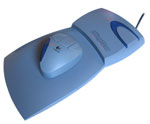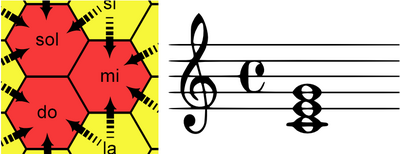Music Haptic : Musical Harmony Notions for All with A Force Feedback Mouse And A Spatial Representation
Bertrand Tornil and Nadine Baptiste-Jessel
Abstract
This paper describes Music Haptic, an application which enables users (especially blind
users) to train of musical harmony notions due to a spatial
representation and a force feedback mouse. This mouse enables the
progressive rebuilding of the mental image of a graphical document
through knowing the positions of its elements. We present technical
context of our prototype and the possible alternatives. Then, we
describe our prototype and discuss directions for future research.
1 Introduction
With their capabilities, computers have often been used in musical
education. Several approach exists in this research
field : graphical visualization [8] [4],
artificial intelligence [9], computer musical analysis
and composition [2].However, these approaches often forget users
with visual disabilities.
In a traditional situation, a blind user or a low vision user uses
a keyboard to interact with a computer. The computer answers him via
a voice synthesis and/or a braille display. This method
is completely adapted to the access to textual documents. With
graphical information, a textual description may be proposed. However,
the problem persists on the one hand because these descriptions are not
always present, and on the other hand because textual
descriptions can quickly prove to be long and tiresome to consult.
Accessibility to the music notation for blind users is based on linear
transcription of musical data into braille notation [1] [17]. It implies
knowledge in musical and harmonical notions, and the comprehension of
the Braille.
The use of force feedback devices was thus studied in accessibility
research [3] [5] [13]
[14] [19]. Indeed, these peripherals authorize
a more direct interaction based on the sensory capacities.
Music Haptic uses a force feedback mouse in order to present some
harmonic informations. First of all, thus, we present how we
use the force feedback modality : we propose the concept of "relative
localization". Then we present the Steedman musical representation
which enables us to use the relative localization for harmony
training. In the next part, we describe the architecture which we
retained for our prototype. Then, we present the features of Music
Haptic at its stage of development. Finally we will finish
by presenting the research orientations which we consider for the future.
2 Haptic interaction
2.1 The force feedback mouse
We use the "Wingman Force Feedback Mouse" (Figure 1) created by
Immersion Corporation [10] and marketed by
Logitech.
The handling surface of this mouse is small : 1.9cm by 2.5cm. Forces
can reach up 1N. Originally, Wingman mouse was conceived for
video-games. However, some research in accessibility [20]
[7] have used this device.
Immersion Corporation proposes a plug-in for Internet Explorer. The plug-in give the possibility of
controlling the mouse via javascript programming.
2.2 Haptic perception with a force feedback mouse
Tactilo-kinesthetic or "haptic" system [15] consists of :
- cutaneous perception : it allows the perception of the
temperature, the pressure or the pain. The sensory receptors are
located under the skin.
- The kinesthetic perception: it makes it possible to feel the position
and the movements of the body. For instance, it enables us to know the
weight, the shape and the position of an object which we are handling.
It is relayed by sensory receptors located in the muscles and the tendons[3]
The handling of a force feedback pointing device, as a
mouse, is based on the kinesthetic perception of the arm and the hand.
The cutaneous perception is not stimulated. Thus, in our approach, it
is not question of feeling a texture, but of perceiving the places where our
hand is located during the handling of the mouse.
2.3 Relative localization
Due to the sensory memory associated with our kinesthetic
perception, we can mentally represent the positions of
the objects. It is what we call the "relative localization".
For instance, in the figure 2,a blind user will
recognize the relative disposition of some french counties on a map
(top example); or, on the bottom example, he will know where the left
arm of the skeleton is.
Coupled to an audio feedback, this approach
will enable blind users to rebuild a mental image of an object starting from
the elements of this object. [18]
We present now how to apply this approach to the music learning field.
3 Seedman representation
In order to use the same approach for music, we need a spatial
representation of musical data.
All of the intervals in tonal music can be represented as
combinations of the fundamental intervals the octave, the
perfect fifth and the major third [11] et
[12]. This creates a three dimensional harmonic representation
although in practice we can represent the space of notes in two
dimensions by collapsing the octave dimension into a single layer
(Figure 3).
There is a further enhancement to this space that can be made and this
was proposed by Mark Steedman [16]. We can
offset the rows of the space by half units to create a space that
allows any particular note to have six adjacent members arranged
hexagonally (Figure 3).
We have chosen this representation because the 6 neighboring notes of
an hexagon are equidistant from the original note. The Fitts law
[6] give an equal movement time to access to these 6
neighborhood hexagons. Moreover, these 6 notes may be considered as the
"most harmonically closed" notes: minor and major thirds, and perfect fifth.
Compared to the original representation, we
carried out a rotation of 60 degrees in order to preserve
the intuitive correlation between pitch height of the note and direction at
the screen: the movements toward the bottom of the screen will always make the sound to go
up (Figure 4).
The main characteristics of this representation are :
- vertical axis consists of perfect fifths;
- axis diagonal-right consists of major thirds; and
- axis diagonal-left consists of minor thirds.
The most important property is the following one: a chord
consist of several connected hexagons which represent a specific
shape, whatever the tonality. The figure 5 shows the
shapes of the implemented chords.
Due to this property, a blind user (and even a sighter user) only have
to learn a chord specific shape, in order to recognize it. Compared
with the traditional musical notation, this is a advantage in a
training task.
For instance, a diminished 7th in E and in F\flat are shown on
figure 6. Chords shapes are different, alterations are
different, but it is the same chord. With the Steedman representation, the diminished 7th
chord consists of four hexagons, whatever the scale.
Moreover, if two chords, in traditional musical notation, seems to have
the same "shape", their nature may be different. For instance, on the
figure 7, the two chords are similar. But, in fact, one is a in major mode,
while the other is in minor mode. The Steedman representation distinguishes
a minor triad chord from a major triad chord, whatever the scale, due to the
orientation of a isosceles triangle : left-oriented
for a major triad and right oriented for a minor triad.
4 Music Haptic : technical aspects
We have chosen a WEB applications context. We have
based our prototype on a client-server architecture.
On the server side, we use Apache Web server. On the client side, we
use Microsoft Internet Explorer. Nowadays, it is the
only browser which support the Immersion Web Plug-in.
The figure 8 shows how our system works.
5 Music Haptic : features of our prototype
In our prototype, we use the Steedman representation in order to
present the different chords to the user.
Two mode are available : Exploration mode and chord mode. In
exploration mode, the user can freely explore the checkerwork of
hexagons. Each note is "displayed" with a force feedback
(Figure 9) and the note is played in the same time.
Keyboard enable to switch in the different chord mode (major and
minor triad, augmented triad, and so on ; see figure 5). In
this configuration, the user only explores the notes of this chord. This
mode enables a blind user to learn the specific shape of a chord. For
example a right oriented isosceles triangle is a major triad chord
(Figure 10).
The last feature enable a sighted user to ask for the traditional
musical notation of the chord. Information sharing between sight and
blind user is easier thank to this feature.
6 Outlooks and conclusion
We currently set up a test protocol to evaluate our approach near
different public : blind people, children and autists. The first blind
user feedbacks we got was encouraging.
We will also continue the development of our prototype
dedicated to the training of the harmony. In particular we will propose
the possibility of recording its own music; the creation of a chord
could be done for example via a gesture recognition with the
mouse.
References
- [1]
-
Braille Music Editor.
web site at : http://www.dodiesis.com/.
- [2]
-
Brandao, P. . W.
Computers in music education.
In Proceedings of the AISB'99 Symposium on Musical
Creativity, (1999), AISB.
- [3]
-
Burdea, G.
Force and touch feedback for virtual reality.
Wiley-Interscience; 1 edition (August 3, 1996), 1996.
- [4]
-
Castaing, J.
Musicdraw : to make music learning attractive.
In Forth MUSICNETWORk Open Workshop :
http://www.interactivemusicnetwork.org/ (Barcelona, Spain, September
2004), Universitat Pompeu Fabra.
- [5]
-
Colwell, C.
Haptic virtual reality for blind computer users.
In Proceedings of ASSETS'98, Third International Conference on
Assistive Technologies (1998), pp. 92-99.
- [6]
-
Fitts, P.
The information capacity of the human motor system in controlling the
amplitude of movement.
Journal of Experimental Psychology 47 (1954), 381-391.
- [7]
-
Gardner, J. A., and Bulatov, V.
Smart figures, svg, and accessible web graphics.
In Proceedings of Technology And Persons With Disabilities
Conference 2001, Los Angeles (2001).
- [8]
-
Holland, S.
Direct manipulation tools for novices based on new cognitive theories
of harmony.
In Proceedings of 1987 International Computer Music
Conference (1987), pp. 182 -189.
- [9]
-
Holland, S.
Artificial intelligence in music education: a critical review.
In Readings in Music and Aritficial Intelligence, Contemporary
Music Studies, E. Miranda, Ed., vol. 20. Harwood Academic Publishers, The
Netherlands, 1999.
- [10]
-
Immersion Corporation.
web site at : http://www.immersion.com, 2005.
- [11]
-
Longuet-Higgins, H.
Letter to a musical friend.
Music Review (August 1962), 244-248.
- [12]
-
Longuet-Higgins, H.
Second letter to a musical friend.
Music Review (Nov. 1962).
- [13]
-
Offen, D., and Thomlinson, B.
Good vibrations: Using a tactile mouse to convey page layout
information to visually impaired computer users.
In Proceedings of CSUN'S Sixteenth Annual International
Conference :"Technology and Persons with Disabilities", Los Angeles
(2001).
- [14]
-
Ramstein, C., Martial, O., Dufresne, A., Carignan, M., Chassé, P., and P.,
M.
Touching and Hearing GUIs: Design issues for the PC-Access System.
In ASSET'96, ACM/SIGCAPH. In 2nd Annual ACM Conference on
Assistive Technologies, Vancouver, BC, Canada (1996), pp. 2-9.
- [15]
-
Revesz, G.
Psychology and art of the blind.
New York: Longmans, 1950.
- [16]
-
Steedman, M.
The formal description of musical perception.
Unpublished phd, University of Edinburgh, University of Edinburgh,
1972.
- [17]
-
Toccata.
Optek systems. web site at :
http://members.optusnet.com.au/ terryk/toccata.htm.
- [18]
-
Tornil, B., and Baptiste-Jessel, N.
Use of force feedback pointing devices for blind users.
In User Interfaces for All (2004), pp. 479-486.
- [19]
-
Wies, E. F., and al.
Web-based touch display for accessible science education.
In Haptic Human-Computer Interaction (2001), pp. 52-60.
- [20]
-
Yu, W., Ramloll, R., and Brewster, S.
Haptic graphs for blind computer users.
Lecture Notes in Computer Science 2058 (2001), 41-49.

